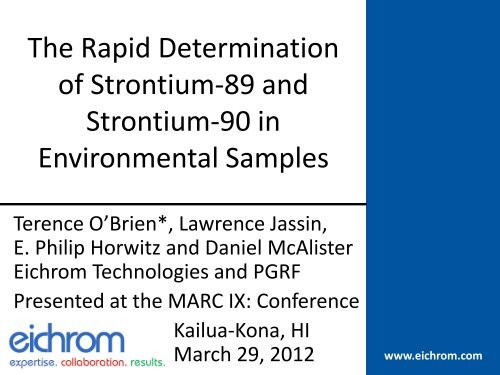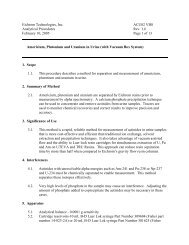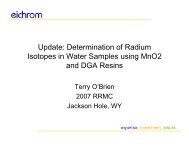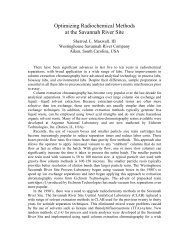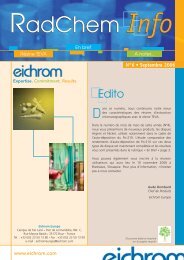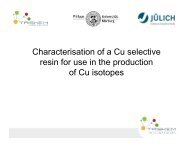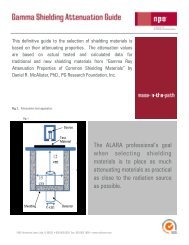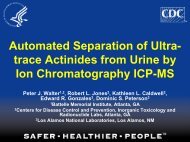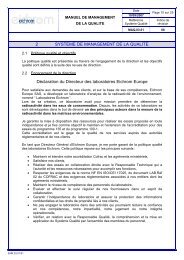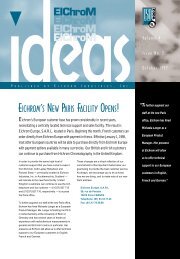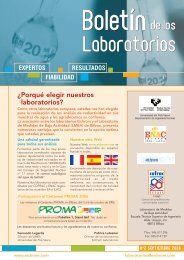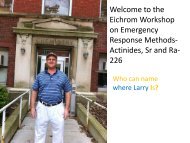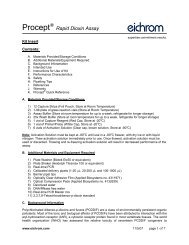Create successful ePaper yourself
Turn your PDF publications into a flip-book with our unique Google optimized e-Paper software.
The Rapid Determination<br />
of Strontium-<strong>89</strong> and<br />
Strontium-<strong>90</strong> in<br />
Environmental Samples<br />
Terence O’Brien*, Lawrence Jassin,<br />
E. Philip Horwitz and Daniel McAlister<br />
<strong>Eichrom</strong> Technologies and PGRF<br />
Presented at www.alarasolutions.com<br />
the MARC IX: Conference<br />
Kailua-Kona, HI<br />
March 29, 2012<br />
www.eichrom.com
Monday, December 6 th , 2011: Japan Today<br />
Some 45 tons of highly radioactive water<br />
The utility is testing seawater samples<br />
leaked Sunday from desalination<br />
taken off the coast near the plant to see<br />
equipment used to decontaminate the<br />
if it is contaminated with strontium.<br />
radioactive water in Tokyo Electric Power<br />
It will know the results in about<br />
Co.'s Fukushima No. 1 nuclear plant and<br />
two to three weeks, Tepco said.<br />
it is unclear if any made it to the sea, a<br />
Tepco official said Monday…<br />
www.eichrom.com
Strontium-<strong>89</strong> & Strontium-<strong>90</strong><br />
www.eichrom.com
Strontium-<strong>89</strong> & Strontium-<strong>90</strong><br />
Strontium-<strong>89</strong><br />
T 1/2 = 50.53 days<br />
Mean Beta energy = 584.6 keV<br />
Mean beta-dose = 0.5846 MeV/Bq-s<br />
Daughter Yttrium-<strong>89</strong> Stable<br />
Strontium-<strong>90</strong><br />
T 1/2 = 28.<strong>90</strong> years<br />
Mean Beta Energy = 195.8 keV<br />
Mean beta-dose = 0.196<br />
MeV/Bq-s<br />
Daughter<br />
Yttrium-<strong>90</strong><br />
T 1/2 = 64.0 hours<br />
Mean Beta Energy = 933.6 keV<br />
Mean beta-dose = 0.9336<br />
MeV/Bq-s<br />
Daughter Zirconium-<strong>90</strong><br />
Stable<br />
www.eichrom.com
The Issues<br />
Some methods for the determination of radioactive<br />
strontium take one of the following approaches.<br />
1. Rapid Radiochemical Method for Total<br />
Radiostrontium (<strong>Sr</strong>-<strong>90</strong>) in Water for Environmental<br />
Restoration Following Homeland Security Events:<br />
2.2.1 This test assumes that it is reasonable to<br />
assume the absence of <strong>89</strong> <strong>Sr</strong> in the sample.<br />
2. <strong>Eichrom</strong> SRW01 – Strontium <strong>89</strong>, <strong>90</strong> in Water<br />
7.9.3 “After yttrium ingrowth of approximately 1<br />
week”<br />
www.eichrom.com
The Issues<br />
3. Rapid separation of actinides and radiostrontium in<br />
vegetation samples<br />
If <strong>89</strong>/<strong>90</strong> <strong>Sr</strong> differentiation is needed, there are Čerenkov<br />
counting techniques for more rapid determination of<br />
<strong>89</strong> <strong>Sr</strong> and <strong>90</strong> <strong>Sr</strong>. <strong>89</strong> <strong>Sr</strong> can be measured directly by<br />
Čerenkov counting, employing methodology that<br />
takes advantage of the high Čerenkov counting<br />
efficiency of <strong>89</strong> <strong>Sr</strong> relative to <strong>90</strong> <strong>Sr</strong> [11].<br />
www.eichrom.com
1. Strontium-<strong>89</strong> and Strontium-<strong>90</strong> could be<br />
present in a sample.<br />
2. Strontium-<strong>90</strong> and Yttrium-<strong>90</strong> will likely be in<br />
equilibrium.<br />
3. Rapid sample turnaround required. – 8 Hrs<br />
4. Many samples to be analyzed. – Multi-<br />
Detector<br />
Assumptions<br />
www.eichrom.com
1 st Tool: Preconcentration<br />
1. For <strong>Sr</strong> Resin – <strong>Sr</strong> k’ around 80-<strong>90</strong>. Therefor<br />
sample volumes above 50 mL should be<br />
avoided to minimize <strong>Sr</strong> break through.<br />
2. Water sample evaporation is an option but<br />
the clock is ticking.<br />
3. Cation Exchange<br />
4. A fast calcium phosphate precipitation can<br />
concentrate both <strong>Sr</strong> and Y.<br />
www.eichrom.com
2 nd Tool: <strong>Sr</strong> Resin<br />
www.eichrom.com
<strong>Sr</strong> Resin<br />
www.eichrom.com
1 10 -2<br />
DGA Resin, Normal<br />
Th<br />
Am<br />
Pu<br />
10 -1<br />
U<br />
[HNO 3 ]<br />
10 0<br />
3 rd Tool: DGA Resin<br />
k'<br />
10 6<br />
10 5<br />
10 4<br />
10 3<br />
10 2<br />
10 1<br />
10 0<br />
10 -1<br />
10 1 10 -2<br />
DGA Resin, Branched<br />
Pu<br />
Th<br />
10 -2<br />
10 -1<br />
Y(III)<br />
Am<br />
U<br />
10 -1<br />
<strong>Sr</strong>(II)<br />
[HNO 3 ]<br />
10 0<br />
[HNO 3 ]<br />
10 0<br />
10 1<br />
10 1<br />
k'<br />
10 6 10 6<br />
10 5<br />
10 5<br />
10 4<br />
10 4<br />
10 3<br />
10 3<br />
10 2<br />
10 2<br />
10 1<br />
10 1<br />
10 0<br />
10 0<br />
10 -1<br />
10 -1<br />
k' for Be and Mg < 1<br />
10 -2<br />
10 -2<br />
Ca(II)<br />
<strong>Sr</strong>(II)<br />
Ba(II)<br />
Ra(II)<br />
for all [HNO 3 ]<br />
Y(III)<br />
<strong>Sr</strong>(II)<br />
10 -1<br />
10 -1<br />
[HNO 3 ]<br />
<strong>Sr</strong><br />
10 0<br />
10 0<br />
Ca<br />
Ra<br />
Ba<br />
10 1<br />
10 1<br />
www.eichrom.com<br />
[HCl]
4 th Tool Vacuum Box<br />
www.eichrom.com
Sample flow rates<br />
1. Recommended: Load/Elution 1 mL / min<br />
Rinse rates of 3 mL / min<br />
2. 2007 RRMC - Julie Gostic reports work with<br />
flow rates of 6-7 mL/min with good<br />
recoveries for Am-241 on TRU and DGA<br />
3. 2009 Maxwell publishes the use of 2-4<br />
mL/min for rapid / emergency sample<br />
analysis.<br />
www.eichrom.com
Flow Sheet: Rapid <strong>Sr</strong>-<strong>89</strong> & <strong>Sr</strong>-<strong>90</strong><br />
Preconcentration<br />
Aliquot & Acidify
Precondition 8M HNO 3<br />
Dissolved Sample<br />
C-Tube Rinse<br />
8M HNO 3•0.5M Al(NO 3) 3<br />
Strontium / Yttrium<br />
Separation and Retention<br />
Reservoir<br />
Reservoir<br />
<strong>Sr</strong><br />
Resin<br />
DGA<br />
Resin<br />
Vacuum Box<br />
Vacuum Box<br />
5 mL 3M HNO3 + 0.05M Oxalic Acid<br />
5 mL 8M HNO3 Elution… 0.05M HNO3 www.eichrom.com
[<strong>Sr</strong>] in ppm<br />
1000<br />
100<br />
10<br />
1<br />
0.1<br />
0.01<br />
Strontium Elution<br />
0.05M HNO3 - 96 %R<br />
0 1 2 3 4 5 6 7 8<br />
Free Bed Volumes<br />
www.eichrom.com
Yttrium on DGA…<br />
Reservoir What could be<br />
there beside Y ?<br />
DGA<br />
Resin<br />
Vacuum Box<br />
How do we get the<br />
Y off without<br />
interferences?<br />
www.eichrom.com
Load/Rinse 8 M HNO 3 with 0.5M Aluminum Nitrate<br />
Rinse with 0.1M HNO 3<br />
Distribution coefficients (Kd) of 60 elements on TODGA resin in<br />
logarithmic scale as a function of HNO www.eichrom.com<br />
3 molarity
Secondary Rinse with 3M HCL<br />
Distribution coefficients (Kd) of 60 elements on TODGA resin in<br />
logarithmic scale as a function of HCl molarity<br />
www.eichrom.com
[Y] in ppm<br />
1000.00<br />
100.00<br />
10.00<br />
1.00<br />
0.10<br />
0.01<br />
Yttrium elution from DGA<br />
0 1 2 3 4 5 6 7 8<br />
Bed Volumn<br />
1M HCl - 27.1 %R<br />
0.5M HCl - 86.2 %R<br />
0.1M HCl - <strong>90</strong>.8 %R<br />
1M Acetic - 84.4 %R<br />
0.5M Acetic - 88.1 %R<br />
www.eichrom.com
Beta Detection<br />
LSC/Cherenkov GPC Low Background Counters<br />
www.eichrom.com
Matrix/Carrier Avg.Recovery RSD%<br />
De-ionized Water<br />
Tap Water:<br />
Carrier Recoveries<br />
Strontium 84.9% 4%<br />
Yttrium -- --<br />
Strontium 75.0% 7%<br />
Yttrium --<br />
Waters; n=4<br />
www.eichrom.com
Sample<br />
Certified<br />
Value<br />
<strong>Sr</strong>-<strong>89</strong> <strong>Sr</strong>-<strong>90</strong><br />
Measured<br />
Value<br />
Difference<br />
±%<br />
Certified<br />
Value<br />
Measured<br />
Value<br />
Blank -0.35±0.37 0.30±023<br />
De-ionized Water-A<br />
2.8±1.2 +18<br />
Difference<br />
±%<br />
0.72±0.27 -40<br />
2.39<br />
1.20<br />
De-ionized Water-B 2.4±1.0 +2 0.97±0.33 -19<br />
±0.05<br />
±0.02<br />
De-ionized Water-C 2.0±.81 -16 1.21±0.38 +1<br />
Tap Water-A<br />
2.7±1.1 +13<br />
1.12±0.38 -7<br />
2.39<br />
1.20<br />
Tap Water-B 2.5±1.0 +5 1.24±0.39 3<br />
±0.05<br />
±0.02<br />
Tap Water-C 3.1±1.3 +30 1.18±0.38 -2<br />
Sample count time was 20 minutes and results are in Bq/L
Estimated Time Line (10 samples)<br />
Step Minutes Elapsed Time (hrs)<br />
Sample Aliquot & Spiking 30 0:30<br />
Sample Pre-Concentration 45+ 1:15<br />
Sample Separation <strong>Sr</strong> & DGA 30 1:45<br />
<strong>Sr</strong> Purification 30 2:15<br />
Y Purification (Concurrent with<br />
<strong>Sr</strong> Purification)<br />
30 --<br />
Sample Mounting (<strong>Sr</strong> & Y) 45 3:00<br />
Counting Time<br />
<strong>Sr</strong>-<strong>89</strong> – 3.5 Bq/L MDA<br />
<strong>Sr</strong>-<strong>90</strong> – 3.0 Bq/L MDA<br />
20+ 3:20<br />
Data Reduction 20 4:00<br />
www.eichrom.com
Future Work<br />
1. Yttrium Yield Measurement Technique<br />
a) Oxalates and Hydroxides<br />
b) Gravimetric vs AA/ICP<br />
2. Interference Rejection<br />
3. Additional Matrix Preparation<br />
www.eichrom.com
Phil Horwitz, Dan McAlister, Larry Jassin at<br />
PRGF and <strong>Eichrom</strong><br />
Acknowledgments<br />
Tim Winters at GEL Labs<br />
Bob Shannon at Quality Radioanalytical Support<br />
Environmental Resource Associates<br />
Thank you for you attention and your questions.<br />
www.eichrom.com


